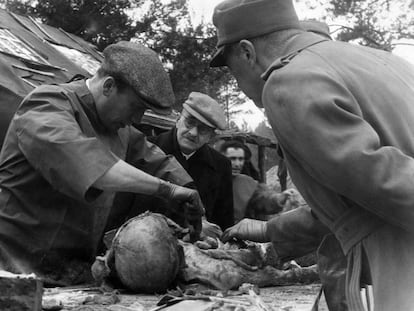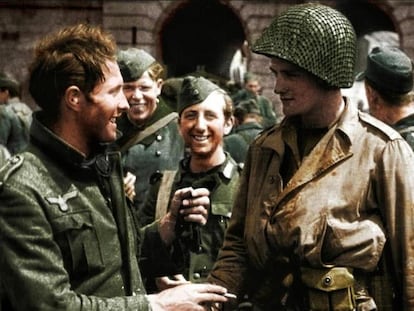French resistance fighter reveals execution of 47 German soldiers in 1944
Edmond Réveil, 98, a combat veteran who witnessed the shooting of prisoners in central France at the end of World War II, says the story ‘needs to be known’
The secret remained hidden for almost 80 years. Nobody said a word. It was nothing to be proud of; it was better to forget it had ever happened. Those who participated in or were present at the execution of 47 unarmed German soldiers, at the end of World War II in the Massif Central in southern France, kept silent all their lives. Some did not even tell their wives or children. Did they feel any regret? “A little, but that’s life,” says Edmond Réveil in the first-floor living room of his small house in Meymac, a village of 2,500 inhabitants in the rural, mountainous region of inland France. At 98, Réveil greets visitors standing, walks up and down stairs and maintains an enviable physique. He also preserves the memory of that day.
Réveil was there on June 12, 1944, when the Communist resistance group to which he belonged shot 47 German soldiers they had captured five days earlier in Tulle, the capital of the Corrèze department, along with a Frenchwoman accused of collaborating. He was nearly 19 years old and a liaison officer in the resistance. He says he did not take part in the shooting. Now he has decided to speak, and in doing so has shone a light on an aspect of World War II, and one that applies to all wars: heroes, sometimes, can also commit atrocities.
“It was necessary that it be known,” Réveil tells EL PAÍS a few days after revealing this unknown episode of the war in Corrèze in an interview with La Vie Corrézienne. “We were ashamed,” he told the local newspaper. “We knew we were not supposed to kill prisoners, even though we were not subject to the Geneva Convention, because the Germans did not consider us soldiers.”
Meymac is as close as a foreigner can get to an idyll of picturesque rural France: a medieval church and tower, a town hall with the French flag flying from the façade and a restaurant, Chez Françoise, which was a favorite of Jacques Chirac, the former president whose electoral fiefdom was located in Corrèze.
Leaving the village, the road winds through woods and passes under the viaduct where, in early 1944, guerrillas derailed a train carrying German armaments. History, its deeds, and its dramas, is hidden behind every bend. Another road winds through a landscape of green hills and farms: somewhere, near the village of Le Vert, lie the remains of the German soldiers.

Where is the burial site, and can it be visited? “Well, no,” smiles the mayor of Meymac, Philippe Brugère. “We know where it is located with a margin of error of a few hundred meters, but we can’t say more than that, because there are grave robbers who would like to find out. People have been seen with metal detectors...”
In 2019, Réveil told the story for the first time at a meeting of the National Assembly of Former Combatants, and a few months later, in September 2020, Mayor Brugère and a group of fellow citizens recorded his testimony. But he had not spoken about the events publicly until now.
“Some people knew about it, but it was like a family secret, which is never told,” says the mayor at a table in the Meymac bookstore-café on the Place de l’Église. Why did Réveil decide to speak out now? “Because he is getting old, because he knows he is not immortal and because before leaving he wanted to ease his conscience and, above all, to ensure that these soldiers have a place of memorial, that their families know their relatives were buried here.”
Robert Gildea, a professor of modern history at the University of Oxford and author of Fighters in the Shadows. A New History of the French resistance (2015), clarifies the context in which the events took place over the phone: “The period between the Normandy landings on June 6, 1944, and the liberation of Paris at the end of August was very volatile in France.”
Brutal repression
Gildea explains that, during those weeks, many resistance groups that had been hiding out in the forests and mountains of France emerged to attack the German occupiers. The subsequent repression, the historian adds, was brutal. For every German soldier killed, if the occupying authorities were unable to arrest a suspect, they unleashed their vengeance against the population.
The context of Nazi reprisals is fundamental to understanding the executions carried out at Meymac. Two days earlier, the Das Reich division of the Waffen-SS had committed one of the worst civilian massacres of the war, killing 642 people at Oradour-sur-Glane, just over an hour’s drive from Meymac. The Nazis had also just hanged 99 men in the streets of Tulle.
A few days earlier, a resistance group had stormed a school building in Tulle that had served as a barracks for the Wehrmacht — the German regular army — and taken dozens of prisoners. They were taken into the forests, in the direction of Meymac. But there was a problem: what was the resistance going to do with them, how were they going to feed them, and how were they going to prevent them from escaping and revealing the location of the guerrillas?
“Every time they went to pee, we had to accompany them,” Réveil said during his 2020 testimony. “We didn’t want to kill them, but we couldn’t keep them with us either: we had to find a solution.”
The order was passed down to kill them and the leader of the group, who went by the nickname of Hannibal and, being from the Alsace region, was fluent in German, “spoke to each of them,” recalled Réveil. “He cried like a child. It’s not pleasant to have to shoot someone. Nobody wanted to kill the French woman. They drew lots.” He adds that the prisoners “dug the holes themselves.”
“It is plain that killing unarmed civilians was against the laws of war,” says historian Gildea. “But it is also true that what the Germans were doing with collective reprisals was also against the laws of war.”
Gildea notes that, while the execution of German prisoners at Meymac may be shocking, in France thousands of collaborators were shot at the end of the war and women suspected of having had relations with the occupying forces suffered humiliating reprisals such as having their heads shaved in public.
Regarding Réveil’s revelations, the historian adds: “If you have a way of looking at the world in which all resistance fighters were heroes and all Germans were Nazis and barbarians, this is the kind of story that doesn’t fit and is shocking, and as such people don’t know what to do with it.”
At the end of June, work will begin to locate the mass grave using radar. If it is found, the remains can be recovered and identified. If the families of the soldiers claim them, they will be repatriated to Germany to be buried with dignity.

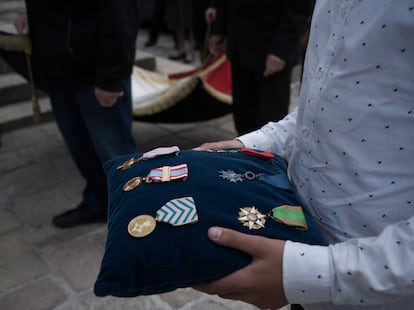
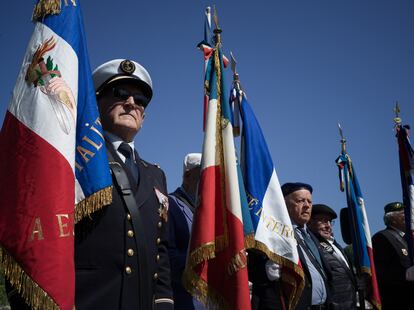
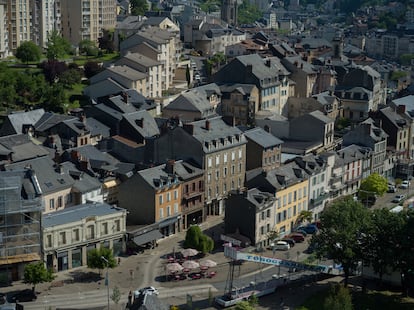
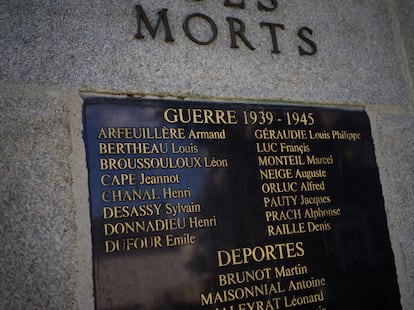
“I hope we are able to find them, but we are not sure,” says Xavier Kompa, director of the National Office for Former Combatants and War Victims in Corrèze, which is preparing to carry out the tracing and exhumation work together with the German War Graves Commission. “Not knowing is terrible for a family,” adds Kompa, whose uncle, a resistance fighter in Lorraine, disappeared at the hands of the SS. “I put myself in the place of German families who would like to know what happened to their ancestors.”
In his house in Meymac, Réveil explains that after working with the resistance, he joined the First Army of General De Lattre de Tassigny, which participated in the liberation of France, and progressed with the advance as far as the German city of Stuttgart. He was a railway man by profession, and proudly explains that during the 1970s he held the position of deputy chief of the Austerlitz station in Paris.
But there is one more memory of the Maquis that he has not forgotten: that of the Spanish Republicans who in 1939 went into exile in France; guerrillas who arrived with battlefield experience and joined the resistance. “Against the Germans,” he says, “they were formidable.”
Sign up for our weekly newsletter to get more English-language news coverage from EL PAÍS USA Edition
Tu suscripción se está usando en otro dispositivo
¿Quieres añadir otro usuario a tu suscripción?
Si continúas leyendo en este dispositivo, no se podrá leer en el otro.
FlechaTu suscripción se está usando en otro dispositivo y solo puedes acceder a EL PAÍS desde un dispositivo a la vez.
Si quieres compartir tu cuenta, cambia tu suscripción a la modalidad Premium, así podrás añadir otro usuario. Cada uno accederá con su propia cuenta de email, lo que os permitirá personalizar vuestra experiencia en EL PAÍS.
¿Tienes una suscripción de empresa? Accede aquí para contratar más cuentas.
En el caso de no saber quién está usando tu cuenta, te recomendamos cambiar tu contraseña aquí.
Si decides continuar compartiendo tu cuenta, este mensaje se mostrará en tu dispositivo y en el de la otra persona que está usando tu cuenta de forma indefinida, afectando a tu experiencia de lectura. Puedes consultar aquí los términos y condiciones de la suscripción digital.
More information
Archived In
Últimas noticias
Trump claims peace in Ukraine is near, but Moscow suggests otherwise
A survivor’s account of the Interoceanic Train accident: ‘We were scared because of the speed on the curve’
The Interoceanic Train, the Mexican alternative to the Panama Canal
What is known about the Interoceanic Train derailment in Oaxaca
Most viewed
- Oona Chaplin: ‘I told James Cameron that I was living in a treehouse and starting a permaculture project with a friend’
- Reinhard Genzel, Nobel laureate in physics: ‘One-minute videos will never give you the truth’
- Why the price of coffee has skyrocketed: from Brazilian plantations to specialty coffee houses
- Pablo Escobar’s hippos: A serious environmental problem, 40 years on
- Chevy Chase, the beloved comedian who was a monster off camera: ‘Not everyone hated him, just the people who’ve worked with him’

